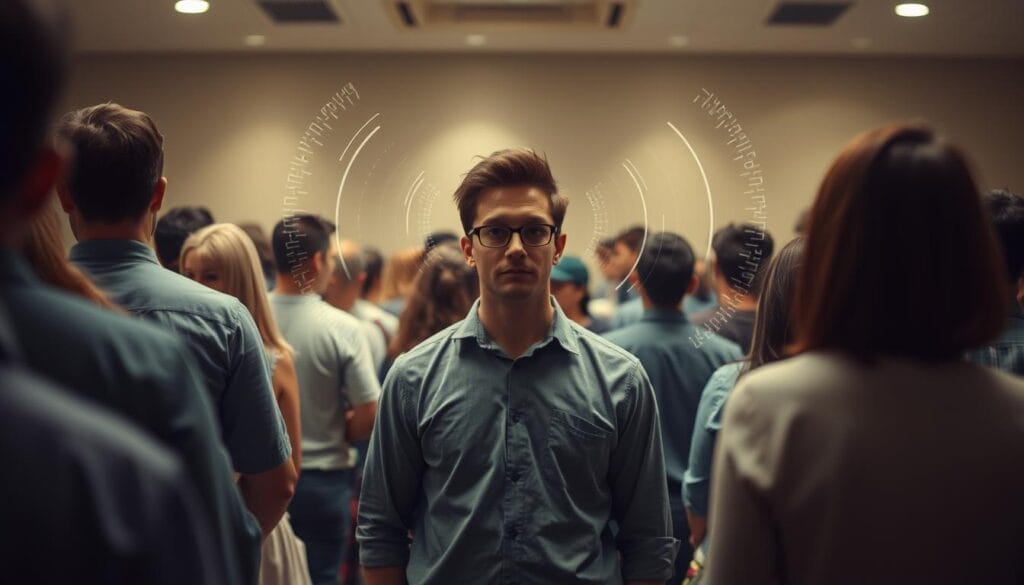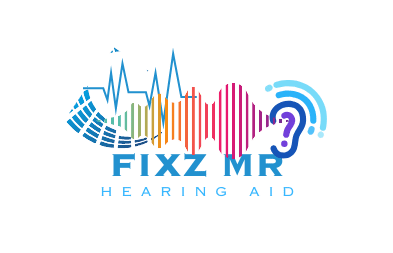Our ears are complex, and finding out why we lose hearing is crucial. With new tech like hearing aids and cochlear implants, many still struggle to hear clearly. This journey is tough, facing challenges from genes to environmental factors. It’s about making sure we can hear every word, every song, and every whisper clearly. Hearing Deficiency Causes
Key Takeaways
- Early identification and managing hearing loss is crucial for quality of life enhancement.
- Genetic research is unveiling exciting potentials in tailored hearing loss treatments.
- Understanding the delicate internal processes of the ear is key to developing future solutions.
- Hearing loss is not merely an auditory issue; it can affect mental and social well-being.
- A comprehensive approach encompassing prevention, treatment, and rehabilitation is vital for those facing hearing deficiencies.
The Critical Role of Genes in Hearing Ability: Insights from GAS2 Research
Scientists are deeply studying how genes affect hearing loss. The Perelman School of Medicine at the University of Pennsylvania has found a key gene, GAS2. This gene helps keep the inner ear’s cells strong, which is vital for hearing.
Understanding the GAS2 Gene and Its Impact on Hearing
The GAS2 gene makes a protein that keeps microtubules in the inner ear’s cells strong. These microtubules are key for sound to travel properly. Studies show that mutations in this gene can cause serious genetic hearing loss.
How Mutations in GAS2 Lead to Auditory Challenges
Research on GAS2 gene mutations shows they greatly affect hearing. A study found these mutations in siblings who were born deaf. These changes harm the gene’s function, leading to hearing loss. This shows we need new ways to fix these genetic problems.
Potentials and Prospects for Gene Therapy in Hearing Loss Treatment
Gene therapy for hearing loss is getting a lot of attention. New technologies like CRISPR-Cas9 and RNA treatments could fix genetic issues early. These methods aim to be more precise and effective, helping people with hereditary hearing loss. You can learn more about these advances at tailored gene therapies.
As research goes on, we hope gene therapy can stop or even fix hearing loss from GAS2 mutations. This would be a big step forward in audiology, helping millions worldwide.
Conductive Hearing Loss: Blockages and Structural Abnormalities
Conductive hearing loss happens when something blocks or changes the way sound moves through the ear. This can be due to blockages in the outer or middle ear. Common causes include earwax buildup, foreign objects, or issues like otosclerosis. Fixing these problems can greatly help your hearing health.
Dealing with conductive hearing loss depends on what’s causing it. Simple ear blockages like earwax can often be removed at home or by a doctor, making hearing better. But, issues like otitis media or otosclerosis might need more serious medical or surgery help.
- Earwax removal: Regular cleaning can stop earwax buildup, a big cause of ear blockage.
- Medical treatment: For infections like otitis media, doctors might give antibiotics or antifungal drugs.
- Surgical options: Surgery can fix or help structural problems causing hearing loss, like fixing middle ear bones.
| Condition | Prevalence | Treatment Approach |
|---|---|---|
| Otosclerosis | 0.04% – 1% in Whites, Up to 5% in Asians | Surgery/Implants |
| Otitis Media | High in children, Lower in adults | Medications |
| Earwax Blockage | Common across all ages | Manual Removal |
| Foreign Objects | Most common in children | Manual Removal by professionals |
Knowing and treating the causes of conductive hearing loss can really improve your life and keep your hearing healthy. Whether it’s simple cleaning or more detailed medical care, it’s key to keep your hearing health in top shape.
Unlocking the Mysteries of Hearing Deficiency Causes
Exploring the causes of hearing problems shows us a complex mix of biology, environment, and lifestyle. Knowing what causes hearing loss helps us prevent and treat it better.
Research has found that congenital CMV infection is a big cause of hearing loss. It’s the most common virus newborns face worldwide. 95% of infected babies show no signs at birth. But, this silent start makes finding it early hard. If not treated, CMV can cause hearing loss over time.
So, it’s crucial to check babies’ hearing often, especially if they didn’t pass the first hearing test. Hearing loss can start months or years after birth. This means we must keep a close watch on these children. Early action can lessen the long-term effects and improve their lives.
Research on animals like chickens gives us hope. Chickens can regrow cells that help them hear after losing their hearing. This could lead to new ways to treat hearing loss in humans.
By combining science and technology, like smart hearing aids, we’re entering a new era in hearing care. This era focuses on preventing hearing loss and offering treatments that fit each person’s needs.
| Factor | Impact on Hearing Health | Intervention Approaches |
|---|---|---|
| Congenital CMV Infection | Leading cause of non-genetic hearing loss in children | Early and ongoing auditory screenings |
| Genetic predisposition | Risk of progressive hearing deficiency | Genetic counseling and monitoring |
| Environmental exposure to noises | Potential permanent hearing loss | Use of protective hearing equipment and education |
Understanding causes of auditory problems helps not just scientists but also millions at risk or already facing hearing loss. By combining research and technology, we can lessen the effects of hearing challenges.
The Intricacy of the Inner Ear Structure and Hearing Loss Factors
Understanding the inner ear structure, especially the cochlea, is key to grasping how we hear and the causes of hearing loss. The cochlea function is vital as it changes sound waves into electrical signals the brain can understand. This process relies heavily on ear development genes, which shape the ear’s parts and how they work.
Research has greatly advanced our knowledge of how genes affect the inner ear’s development and function. For example, genes like Gas2 are not just blueprints but also key for the ear’s sensory abilities. Without these genes, hearing loss can be severe, highlighting the role of genetic studies in understanding hearing health.
This research has real-world benefits for diagnosing and treating hearing loss. By identifying specific ear development genes, doctors can tailor treatments for different hearing problems. This leads to more effective care for those with hearing loss.
| Gene | Function in Ear Development | Impact on Hearing Loss |
|---|---|---|
| Gas2 | Crucial in cochlear cell structuring | Significant hearing impairment in absence |
| GDF6 | Controls expression related to ear formation | Essential for auditory system integrity |
| POU3F4 | Involved in cochlear nerve development | Linked to X-linked mixed deafness |
Studying the cochlea function and its genetic basis helps us understand hearing better. It also leads to better ways to prevent and treat hearing problems. By focusing on the inner ear structure and its genetic influences, we can improve hearing health care.
Evidence-based Analysis: The Prevalence and Seriousness of Hearing Impairment
Many people worldwide face hearing loss, showing the need for early detection and understanding of hearing issues. Research on genes like GAS2 helps us find ways to treat hearing problems early. This could lead to better hearing health care.
GAS2 Mutations as an Indicative Marker for Hearing Loss
Studies show that GAS2 gene mutations affect the cochlea’s structure, causing hearing loss. This knowledge could lead to new ways to catch hearing problems early. It might help stop hearing loss before it starts.
The Role of Early Detection and Intervention in Hearing Health
Finding hearing loss early makes treatments work better and can stop it from getting worse. Doctors can use new gene therapies if they catch hearing loss early, especially in young people. This could help a lot.
Understanding why hearing loss happens and using genetic research in health plans is a smart move. It helps tackle hearing health issues in a new way.
| Region | Individuals with Moderate-to-Complete Hearing Loss (millions) |
|---|---|
| Western Pacific | 127.1 |
| Global Projection for 2050 | 2.45 billion |
| Years Lived with Disability (million years) | 43.45 |
| Incidence Rate per 1,000 (Beaver Dam, WI, USA) | 42.8 |
Statistics and research show that early detection and understanding of genes like GAS2 can lessen hearing loss in the future. Knowing more about hearing issues helps make better health policies and care for individuals.
Advancements in Hearing Loss Treatments and Rehabilitation Options

Recent progress in hearing loss treatment advancements has opened new doors for better hearing health. It’s making a big difference in the lives of people with hearing problems. New hearing technologies and focused rehabilitation for auditory problems are changing the game in hearing care.
Leading-edge devices like cochlear implants and advanced hearing aids are changing lives. They don’t just make sounds louder. They’re getting smarter, using AI to make listening better based on the setting. Gene therapy is also showing promise, aiming to fix the genetic causes of hearing loss for good.
Early detection and screening are key. Now, tests look for genes that might lead to hearing loss later. This helps catch problems early and start treatment right away.
Rehabilitation for auditory problems goes beyond just devices. It includes therapy to help people adjust to their hearing aids or implants. This makes sure they get the most out of their devices, blending them into everyday life smoothly.
For more on how medication affects hearing, check out this resource. It covers the safety and effects of medicines on hearing health, showing how to manage them with hearing care.
| Treatment | Objective | Impact |
|---|---|---|
| Hearing Aids | Amplify sound | Improves daily communication |
| Cochlear Implants | Directly stimulate auditory nerve | Allows perception of sound in severe cases |
| Gene Therapy | Target genetic deficits | Potential for long-term correction of hearing loss |
| Auditory Training | Enhance sound recognition | Improves adaptation to hearing devices |
The world of hearing loss treatment advancements is changing fast. It’s driven by new tech and a better understanding of how we hear. These changes are not just about fixing hearing. They’re about making life better for people with hearing loss.
Environmental and Lifestyle Contributions to Hearing Deficiency
Our surroundings and daily habits greatly affect our hearing health. It’s crucial to understand how environmental noise and our lifestyle choices impact our hearing. Prolonged exposure to loud noises can cause permanent damage if we don’t take steps to protect ourselves.
How Daily Habits and Exposure to Noise Affect Hearing
Exposure to loud noises over time can harm our hearing. For example, sounds above 75-80 dBA can lead to serious hearing loss. Studies show that being in noisy places often makes hearing worse over time.
Activities like going to loud concerts, listening to music too loudly, or working in a noisy place without ear protection increase the risk. This highlights the need for awareness and prevention in our daily lives.
Practical Strategies for Preserving Hearing Health in Noisy Environments
To protect our hearing, we need to take practical steps. This includes wearing earplugs or noise-canceling headphones in loud places, keeping the volume low on our devices, and getting regular hearing tests. These actions reduce the risk of hearing loss and improve our overall well-being.
| Noise Level (dBA) | Impact on Hearing | Preventative Measures |
|---|---|---|
| 75-80 | Increased risk of hearing loss with prolonged exposure | Use of protective earplugs or earmuffs in noisy environments |
| 85-90 | Presumed noise-induced permanent threshold shift possible | Regular breaks from noise, ear protection gear adherence |
| 100+ | High risk of immediate and permanent hearing damage | Limit exposure time, seek quieter alternatives |
Understanding how our environment and habits affect our hearing is crucial. By taking steps to protect ourselves, we can prevent hearing loss and improve our health. This shows the strong link between our lifestyle and hearing health.
Deciphering the Symptoms and Types of Hearing Loss
Hearing loss is a common issue that comes in many forms. Each type needs its own way of being diagnosed and treated. Knowing the types of hearing deficiency and spotting symptoms of hearing loss is key to tackling this health issue.
We’ll look into the details of hearing loss. We’ll cover its main types and point out the early hearing loss signs. These signs tell people it’s time to get medical help.
Distinguishing Between Conductive and Sensorineural Hearing Loss
Conductive hearing loss happens when something blocks the sound from getting to the inner ear. This can be due to issues with the outer ear, eardrum, or middle ear. On the other hand, sensorineural hearing loss is caused by damage to the inner ear or the nerve paths to the brain. This can be from aging, loud noises, or inherited conditions.
| Type of Hearing Loss | Cause | Common Symptoms |
|---|---|---|
| Conductive | Blockages, ear infections, structural anomalies | Reduced ability to hear faint sounds, clearer hearing in noisy places |
| Sensorineural | Aging, loud noises, hereditary factors | Difficulty understanding speech, especially in noisy places |
| Mixed | Combination of conductive and sensorineural causes | Symptoms of both types, often varying in intensity |
Recognizing the Signs of Early Hearing Deficiency
It’s important to spot early hearing loss signs early. These signs include trouble understanding conversations, asking people to repeat themselves, or turning up the volume on devices too high.
Tinnitus is another sign that often comes with hearing loss. It’s when you hear ringing, hissing, or roaring sounds in your ears. This could mean there’s a problem with your hearing. Knowing these signs can help get you the right treatment faster, which can prevent more serious problems later.
Also, knowing how things like loud noises or some medicines can affect your hearing can help you protect it. Using hearing protectors and getting regular hearing checks are good ways to keep your hearing sharp and improve your overall health.
Understanding the different types of hearing deficiency and watching for symptoms of hearing loss helps people take care of their hearing. Catching hearing problems early and getting the right treatment can make a big difference for those with hearing loss.
Personalized Hearing Solutions: Tailoring Treatment to Individual Needs
In the world of hearing health, personalized hearing solutions and individualized auditory care are key. Everyone’s hearing loss is different, so treatments and technologies must match their unique needs. This part talks about how to pick the right hearing aid and the special care given by audiologists.
Considerations for Selecting the Right Hearing Aid Technology
Choosing the right hearing aid means knowing the type and level of hearing loss you have. Whether it’s conductive, sensorineural, or mixed, each type needs a specific type of technology. Advanced hearing aids made for your ear shape greatly improve sound quality and comfort. Audiologists help by considering your lifestyle, hearing loss level, and budget to find the best option.
Customized Care Approach from Audiologists and Hearing Specialists
Audiologists are crucial in giving individualized auditory care. They do detailed tests and support to make hearing aids work better. The move to custom-fit hearing aids shows a shift to more personalized care, making sounds clearer and users happier. This focus on the patient means you get devices that fit your hearing perfectly.
Custom hearing aids made for your ear shape are a big step forward in personalized hearing solutions. They’re great for complex hearing problems like selective frequency losses or loud sounds that bother you. These devices can’t be replaced by standard models.
| Hearing Loss Type | Technology Needed | Customization Level | Expected Benefits |
|---|---|---|---|
| Conductive | Standard or Amplifying | Low | Clearer sound transmission |
| Sensorineural | Advanced Digital | High | Improved sound quality, frequency adjustments |
| Mixed | Hybrid Technology | High | Combination of clarity and customization |
| All Types | Earprint-based Custom Devices | Very High | Optimal comfort, natural sound quality |
The table shows how different hearing losses need different technologies and custom levels. Earprint-based solutions offer a high level of personalized care, leading to better hearing. These advanced technologies are more expensive and take more time to fit, but they greatly improve hearing and comfort over time.
In conclusion, improving hearing is a deeply personal journey. With compassionate, individualized auditory care and advanced hearing aid selection, audiologists help many people overcome hearing challenges. Personalized hearing solutions are not just a service; they’re a life-changing experience.
The Psychological and Social Implications of Hearing Issues

The psychological impact of hearing loss is deep, touching many parts of a person’s life. Those with hearing problems face not just physical hurdles but also emotional and psychological challenges. They may feel isolated or frustrated, which can hurt their relationships and mental health.
Dealing with social challenges in hearing deficiency makes everyday interactions harder. Going to social events can be tough, and keeping up with friends and family takes more effort. This can lead to feeling left out, raising the chance of getting depression or anxiety.
But, there are ways to handle coping with hearing impairment well. Using hearing aids, cochlear implants, and other devices can make talking easier and reduce feelings of loneliness.
- Using hearing aids, cochlear implants, and other assistive devices can dramatically improve the ability to communicate, thereby decreasing isolation.
- Encouraging regular social interactions, perhaps in environments tailored to their needs, helps maintain vital social connections and mental health.
- Educational programs aimed at friends and families of individuals suffering from hearing loss can foster a more understanding and supportive environment.
Recent studies show a link between hearing loss and dementia. Mild to severe hearing loss raises the risk of dementia. Early hearing help could improve life quality and might even lower the risk of losing cognitive abilities.
It’s important to understand the mental and social sides of hearing loss. Helping people from diagnosis to treatment and highlighting the need for social support can lead to better health for those with hearing issues.
Exploring the Link Between Tinnitus and Hearing Deficiency
Understanding the link between tinnitus and hearing loss is key in both medical and treatment settings. It’s thought that 10 to 25% of adults deal with tinnitus. The science of tinnitus shows a strong connection with hearing loss. We’ll look into the biological and psychological sides of this health issue.
Unveiling the Underlying Conditions Causing Tinnitus
Tinnitus has many causes, from nerve problems to noise and certain medicines. Doctors work hard to find the right treatment. Some tinnitus comes from earwax or infections, but others are linked to serious health issues like high blood pressure or diabetes. This shows we need a team approach to treat it.
Breaking Down the Science of Persistent Ear Ringing
The science of tinnitus is complex, involving the brain and nerves. Most tinnitus is inside the person’s head, but some can be detected by doctors. The connection between tinnitus and hearing loss is strong, as seen in studies like the one from NCBI. They show how ear damage can help us understand this link better.
| Tinnitus Impact | % of Adults | Associated Factors |
|---|---|---|
| Experiencing Tinnitus | 10-25% | Loud noise exposure, ototoxic drugs |
| Linked to Hearing Loss | 90% | Aging, auditory nerve damage |
| Severe Impact on Life Quality | Variable | Stress, sleep disturbances, concentration issues |
Managing tinnitus well means using therapies like cognitive behavioral therapy and tinnitus retraining therapy. These help reduce the effects of tinnitus and improve life quality. Creating treatment plans that match the person’s specific needs can lead to better results and maybe even reduce tinnitus over time.
Conclusion
Over 1.1 billion people worldwide face hearing impairment, making it a major concern. Studies have deepened our understanding of hearing loss. We now see how genetics, environment, and lifestyle affect hearing.
With over 466 million people facing disabling hearing loss, we must look closely at the numbers. Some in the Deaf community prefer their identity and don’t want to fix their hearing. But many want better hearing as they get older.
Cognitive decline and social isolation are linked to hearing loss, leading to more health problems. Yet, human innovation offers hope. The FDA’s approval of over-the-counter hearing aids means more people can get help, improving many lives.
Health professionals are at a turning point, using new insights to create a better future. Even though few use hearing aids fully, awareness and cost are making them more accessible. With more older people, managing hearing loss is more important than ever. We’re excited to help people enjoy life’s sounds more fully.







